We’ve just returned from spending 11 wonderful days in Western Crete, Greece. As the largest island in Greece, and the fifth largest in the Mediterranean, there is a lot to see and do and we only really scratched the surface, visiting the area between Chania and Rethymnon, plus the nearby mountains and southern coast. In that short time we managed to visit magnificent mountain villages, a winery, some gorgeous beaches, walked a stunning gorge, saw a turtle nest being examined and enjoyed wandering through Venetian and Turkish harbours and towns.
Out first week was in a lovely 3 bedroom villa set in a wide rural valley just south of the small resorts of Kalyves and Almyrida on the north-west coast. Our views were across this pastoral scene to the nearby village of Gavalochori and then over the sea to the peninsula of Akrotiri with enormous Souda Bay in between. To the west, the sun set over the looming peaks of the Lefki Ori, White Mountains, with peaks reaching up to 2,453m (there was still snow in August this year). It was an incredibly peaceful scene and seemed to encapsulate much of Crete – despite being only 5km from the sea it was very much a rural landscape. Cicadas chirped all day long and the only other noises were donkeys, dogs and cockerels!



We rented the villa through our close partners CV Villas. Set in an olive grove there was plenty of outside space with 3 or 4 different terraces, one always in shade, and lovely pool area. It was built in a traditional style, which plenty of stonework, and was comfortable, modern and well equipped. The traditional welcome pack was filled with fine local Cretan delicacies including olive oil and honey from the farm. We were encouraged to eat the delicious ripe figs from the trees. The owner, Penelope, was local and her Dutch husband was an artist who had one many fine pieces of the area. The icing on the cake was the local village, Gavalochori. It was about 10 mins walk away and in the main square were two excellent restaurants, under fine shady trees, a couple of corner shops and bakery. The local café, Kefanion, seemed the centre of life, the owner’s son having just returned from Atlanta had got his mother to cook delicious local dishes. The tables spilled out onto the street and across the road – it was so popular. The village also had a very good local folklore museum and some fine, and well-marked, local walks.


Located about 45 mins from Chania Airport this was a great base to explore the region. The beaches at Kalyves and Almyrida were <10 mins away with soft sand and plenty of facilities without feeling too busy. The local inland towns of Vamos and Vrysses have many other shops with everything we needed like a butcher or baklava (!) bakery and the latter town had a really charming centre with cafes and restaurants lining the shaded river-side and ducks aplenty. We had a great lunch there with the biggest kebabs ever, the twice cooked pork was not for the faint-hearted. Close by too is the Dourakis Winery founded in the 1980s with a wide range of organic wines using local Cretan grape varieties. You can tour the cellars and production area and taste the wines under a gorgeous shady arbor. We also spent a day on the very fine Georgioupolis Beach just to the east. This 10km stretch was gorgeous with the mountains as a backdrop and all the facilities you needed. We spent a relaxing birthday at the Tropicana Beach Club using their cabanas and eating yards from the sea.




Chania itself was <45 mins away and what a great place to explore. The narrow maze of alleys in the old town opened up onto the harbour with its old mosque on the waterfront and Venetian fortifications around the harbour. It felt like a proper buzzing city and although there were plenty of tourists it was also very Greek. We ate a very fine seafood meal, one of our only ones (see below) on the waterfront and got lost a couple of times as we explored the city. To end our visit we stopped off at the Commonwealth Cemetery in Souda Bay. Most of those honoured here had fallen fighting in the German invasion of Crete in May 1941 and the setting is simply beautiful with the waters of the harbour stretching away into the distance beyond the tombstones




We had planned to hike one of the famous south coast gorges and on the advice of our villa owner opted for the Aradhena gorge – less popular than Samaria (and much shorter) it is also prettier and ends at the sea, unlike the Imbros Gorge. The drive over to the south coast is stunning, heading up first onto the plateau of Askifou and then along the dramatic Imbros Gorge with great viewpoints. This was also the route taken by the retreating British and Commonwealth forces in May 1941 (and described in detail in Evelyn Waugh’s book Officers and Gentlemen). Once past here you drop straight down to the sea on the south coast, far more barren and rugged than the north. The bustling & charming port of Chora Sfakion is the only town of any size and from here we took a taxi back up into the mountains to the head of the gorge. Eagles and vultures circled high up and all the road-signs were riddled with bullet holes – apparently the locals use them for target practice. The deserted village of Aradhena (abandoned due to a feud) is the starting point and we headed from here down a zig-zag ancient stone path to the gorge floor with soaring sides and a rattly wooden bridge far above us. The flat, rocky gorge floor was constantly deceptive, as while there was plenty of flat sections there were also huge boulders and rocky steps to be traversed all the way down. At some stages we used ladders and a rope on a scree slope and every now and again we came across flocks of goats. It was stunning, exciting, and beautiful and took about 3 hours to complete. You have to take your own water and good trainers/walking shoes are a must but it is not technical. Apart from the sheer scale and beauty of the gorge the highlights were seeing eagles on a nest up above and the final sight of the sea as you arrive at gorgeous Marmara beach on the south coast. The wonderful taverna here served magnificent stews and baked dishes and afterwards we enjoyed the lovely beach with the clearest water. We caught the boat back to Chora Sfakion, passing the small village of Loutro on the way. All in all a brilliant day out.









The second part of the holiday was at the Grecotel White Palace to the east of Rethymnon. Set right on the beach it was as different as you could get from the rural setting of the villa. With wonderful sea views, great pools, spacious sandy beach and a superb collection of restaurants we were very impressed. The staff were unfailingly superb and its rooftop bar was a wonderful setting for sunset drinks, looking along the beach to Rethymnon and the White Mountains beyond. It was family friendly, with plenty of activities for kids, however being so spacious it was never noisy nor felt busy – its public areas were very well designed and it had large and airy rooms and balconies.




One morning on our way to breakfast we bumped into the team from the Archelon Trust, a Sea Turtle Protection Society, and they suggested we come along to their dig that evening. About 10 days after a nest starts hatching they dig it up to see what happened to the eggs – how many hatched, how many didn’t and to help any stragglers along. They mark any nests they can, to avoid damage from beach users, and we watched as they slowly uncovered the nest. There were a total of 115 eggs of which 111 had successfully hatched and 4 had never developed. This was really positive for a species which is critically endangered in the Mediterranean and Greece – its preferred sandy beaches are also the locations most suited for tourism development! If they had one simple message it was no lights on the beach at night and no more development close to the water.




As always we took the time to explore the area. The hotel was about 5 miles from Rethymnon and we much enjoyed our visit there. A smaller and less busy Chania, is an easy way to describe it, although the big difference is the Fortezza, citadel, which dominates the town (and coastline). The harbour is much smaller and more intimate, with restaurants just feet from the water, and some alleyways were just so narrow that the floors above were almost touching. There’s a fine archaeological museum, however, the Fortezza is the main sight. Built by the Venetians in the 16th century, possibly the largest they ever constructed, it was subsequently used by the Ottomans and Germans. The views along the coast in either direction are glorious and you get a great overview of the narrow lanes of the old town from above.



We also headed inland to the historic monastery of Arkhadi, a shrine to Cretan independence. It is in a scenic upland location with a charming main courtyard. However the most striking part is the roofless vault, where the ammunition stores were detonated in the Turkish siege of 1866, killing 100s of attackers and the women and children who had taken shelter. It became a rallying cry for the island and caused a wave of sympathy across Europe. There was also the chance to visit the charming mountain village of Aryiroupoli, scenically located and awash with mountain streams and ponds. There were fine views north to the sea and the upper village sits on the ruins of the ancient settlement of Lappa.




We ate extremely well in every location. What was most unexpected, however, was the huge preponderance of meat and cheese dishes rather than seafood and fish we are generally used to in Greece. We expected it inland, even though Gavalochori was only 5km from the beach, but even by the sea, such as the wonderful taverna on the beach in Marmara, all the signature dishes were lamb, pork or mutton bakes and stews. The best meal of all might have been the BBQ/refried pork by the river in Vyresses, and everything was washed down with fine local wines and the ubiquitous raki and grapes to finish each meal.




One special mention should go to a classic Cretan dish that in 30 years of visiting Greece I had not come across until earlier this year. Dakos is made from barley rusks/or soaked dried bread, Cretan soft cheese (mizithra), tomatoes, olives and capers. We had it every day and it came in all shapes and sizes from small canape style (think bruschetta) to hefty bowls that were a meal to themselves. What a find!




For those who like walking, the trails are numerous from the famous gorges in the south to village walks which seemed everywhere. This can be done year round, with particular highlights in the spring when the wild flowers are spectacular in April and May.
So in 11 days we managed plenty of both relaxing and exploring. Visiting this island at the end of August/early September meant less crowds and temperatures averaging around 25-30 degrees. Temperatures will remain well over 20 in September and through into October, with the sea staying warm, so it’s not too late to visit in the Autumn. For culture, weather, walking, beach and food it is hard to beat Crete – and we hardly even scratched the surface of it. We hope to return next year!











 by TMS
by TMS